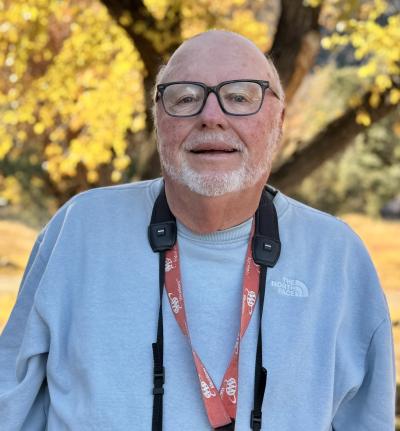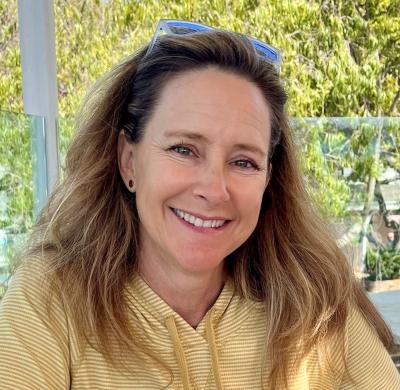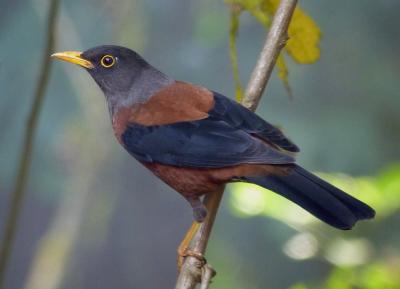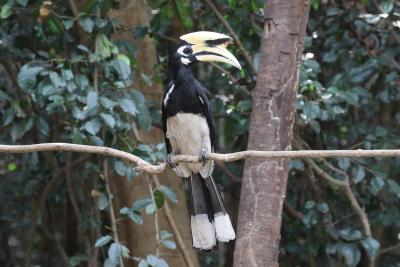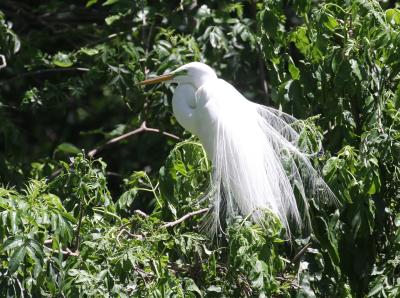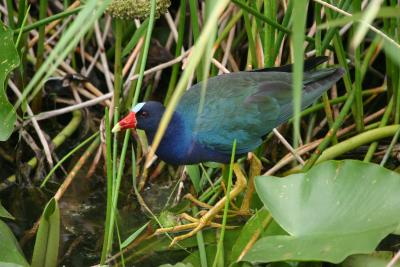Maryland and West Virginia
Birding the American Civil War: Gettysburg, Antietam, and the Appalachians
-
Jun 2027
Jon Dunn
Tour Price to be Determined
Tour Price to be Determined
General Robert E. Lee made two forays north into Union territory, the first in September 1862 and the other in late June of the following year. Lee had multiple reasons for both invasions, but a primary goal was to relieve pressure on the beleaguered South, especially in the West. By the spring of 1863, this was along the Mississippi River at Vicksburg. He hoped that significant victories might force the North to give the South its independence, or more realistically cause other countries, particularly France, and Great Britain to officially recognize them. The resulting battles were both tactical defeats for Lee. The first, at Antietam, Maryland, resulted in the highest number of casualties on any day of the entire war. Less than a year later, the three-day battle at Gettysburg, Pennsylvania, was the costliest of the war, the “highwater mark of the Confederacy.” The South would never again be able to mount a sustained offensive, and its eventual defeat nearly two years later was ordained here at Gettysburg.
Our tour takes us to both of these famous battlefields and to Harpers Ferry, where John Brown’s famous October 1859 raid was soundly repulsed by US forces—under Robert E. Lee, and where Stonewall Jackson’s victory and the surrender of 12,500 Union troops in September 1862 (part of the Antietam campaign) was the greatest federal disaster until January of 1942 when a larger force surrendered at Bataan, the Philippines.
We’ll spend some time birding around Frederick, Maryland, and around Gettysburg, but the bulk of our birding will be in West Virginia, from around Harpers Ferry, the lowest point in West Virginia, to the high Appalachians and the dramatic New River Gorge east of Charleston. In the Appalachians, bird and song activity should still be high, and wildflowers will be at their peak. In the course of the tour we can anticipate seeing 25 or more species of wood warblers, including Cerulean, Mourning, Louisiana and Northern Waterthrushes, and possibly Golden-winged and Swainson’s, as well as Yellow-billed and perhaps Black-billed Cuckoos, Acadian, Willow, Least, and Alder Flycatchers, and possibly Henslow’s Sparrow.
This tour is one in a series organized by Jon to explore the history and natural history of the sites associated with the American Civil War.
Day 1: The tour begins with dinner near Baltimore, Maryland. Night in Baltimore.
This was my first WINGS tour so I really have nothing to compare it to. Jon and Matt were wonderful tour guides. Their birding skills left me speechless. So many new birds for my life list. The people I met were awesome and I hope to see all of them again. The camaraderie was wonderful. I had a great time and can’t wait to book another WINGS tour! -Andrew K.
Day 2: We’ll leave this morning for Gettysburg, the small southern Pennsylvania town where the climactic battle of the Civil War was fought in the first days of July 1863. General Robert E. Lee had invaded the North a few weeks before, after his decisive May victory at Chancellorsville; the incursion was partially motivated by the need to relieve Union pressure on Vicksburg and other strategic sites in the deep South. The Army of the Potomac responded, engaging Lee here at Gettysburg. For three full days the battle raged, climaxing in Pickett’s Charge at Cemetery Ridge, although tactically the battle had already been decided by the end of day two perhaps due in part to the heroics of Chamberlain and the 20th Maine (plus others) at Little Round Top and the First Minnesotan closer to Cemetery Ridge. Claiming more than 50,000 casualties, Gettysburg was the bloodiest battle of the war and a decisive defeat for Lee, who would henceforth be on the defensive: the war dragged on for nearly two more years, but Lee’s fate and the fate of the South were sealed here.
We’ll spend the entire day visiting the major sites of the battle and the new visitor’s center where we’ll see a film and then see the restored Cyclorama which portrays the events on the culmination of day three of the battle. Birds in evidence on the open farmlands and in the oak woods might include Red-headed Woodpecker, Carolina Chickadee, Wood Thrush, Orchard Oriole, and Field Sparrow. After an early dinner in Gettysburg, we’ll continue on to Harpers Ferry, West Virginia. Night in Harpers Ferry.
Day 3: This morning we’ll visit Antietam, where the fighting of September 17, 1862, resulted in 23,000 casualties—more than on any other single day of the Civil War. Lee faced George McClellan, whose army not only outnumbered the southern forces but had also come into possession of Lee’s war plans (the now famous Order 191), which had been dropped by mistake along the road and retrieved by a Union soldier. In spite of this, the battle was not decisive, though it did result in Lee’s retreating back into Virginia, providing the Union a strategic victory. But, had McClellan not dithered for over a day and engaged his entire force, there is little question that Lee’s Army would have been smashed. This would have possibly led to an early end of the Civil War and saved hundreds of thousands of lives. McClellan’s inability to achieve a definitive victory and his reluctance to pursue Lee’s retreating army in Virginia convinced Lincoln that the Army of the Potomac would soon need a new leader. Lincoln previewed his decision with his famous quotation: “If General McClellan isn’t going to use his army, I’d like to borrow it for a time.” At Antietam, grassland sparrows such as Grasshopper, Field, and possibly Vesper should be much in evidence as they sing from the restored Civil War era picket fences. Overhead there should be Black and Turkey Vultures and we’ll check the crows carefully for the hoarser sounding Fish Crows. On our way to lunch in Sheperdstown, we’ll stop at the Lock 38 on the B & O Canal next to the Potomac River. Here there should be woodland species like Acadian Flycatcher and Yellow-throated Warbler.
Later in the afternoon we’ll visit Harpers Ferry, the site of John Brown’s famous raid of October 16-18, 1859. Brown was an ardent abolitionist, and it was his Kansas exploits a few years earlier that gave that territory the name “Bloody Kansas.” The federal forces sent to retake the armory at Harpers Ferry were led—ironically—by Robert E. Lee; the armory was ultimately retaken, and John Brown and others were hanged by the end of the year. It would also figure prominently in the action at Antietam. The fall of Harpers Ferry and all of the armaments to Confederate forces, allowed first Jackson, then A.P. Hill the following day to march quickly back to Antietam late in the day but just in time to relieve Lee’s forces at the south end of the Antietam battlefield. The confluence of the Shenandoah and Potomac rivers offers stunning scenery and here we should see a variety of species including perhaps nesting Ospreys. In 2021, a pair of Peregrine Falcons nested here across the Potomac in Maryland, the first time in well over a half century. From here, we’ll drive west to Martinsburg where we’ll have dinner and be joined by Matt Orsie, our co-leader and one of West Virginia’s best birders. After dinner and weather permitting, we will head west to do a bit of evening birding around Sleepy Creek WMA; we’ll be in search of Eastern Whip-poor-will and perhaps Barred Owl or Eastern Screech-Owl. Night in Harpers Ferry.
Day 4: We’ll leave early to bird briefly in Loudoun County, Virginia, and along the Shenandoah River, West Virginia where we’ll have our best chance at Prothonotary Warbler; we should also see Kentucky, Yellow-throated Warbler, Northern Parula and possibly Cerulean. Warbling Vireos (larger eastern subspecies, a possible split from the smaller western birds that sing differently) should be much in evidence in the tall trees along the Shenandoah. Moving on to eastern Berkeley County, West Virginia, we’ll bird second-growth woodland for White-eyed Vireo, Prairie Warbler, and Yellow-breasted Chat. Then we’ll return to Sleepy Creek, one of the best forests in eastern West Virginia for breeding warblers. Here we’ll hope to see the threatened Cerulean Warbler, a small population of which nests here. Other warblers we can hope to see include Prairie, Black-and-white, Worm-eating, American Redstart, Louisiana Waterthrush, and Ovenbird. Yellow-billed Cuckoo and Acadian Flycatcher should also be present, along with a wide variety of other deciduous-forest passerines. We’ll check the numerous Turkey Vultures overhead for a Black Vulture or a Broad-winged Hawk. If we have time we may check the Kimsey Lake area or elsewhere where a few Red-headed Woodpeckers may be present.
Later we’ll head west, leaving the hot eastern lowlands for the cool and lushly wooded Appalachian Mountains. Night at the lodge in Canaan Valley State Park.
Day 5: The mixed deciduous and spruce forest of the high Appalachians at Canaan Valley State Park and nearby Dolly Sods Scenic Area should be full of warblers. Yellow-rumped, and Magnolia are near the southern end of their breeding ranges here. Black-throated Blue, Black-throated Green, and Blackburnian Warblers should be fairly numerous. We’ll search the bogs for Northern Waterthrushes and Alder Flycatchers (sometimes side by side with Willow Flycatcher in the Canaan Valley), and in the secondary edge forest we might find Golden-winged Warbler. In the dense spruce we should find Winter Wren, Brown Creeper, Golden-crowned Kinglet, Hermit Thrush and Purple Finch (eastern subspecies). To the north, near the Maryland border, there are some reclaimed strip mines where we might find the always local, and usually scarce, Henslow’s Sparrow. We have not seen it on the last few trips. We should see Bobolinks in the grasslands of the Canaan Valley along with a few Savannah Sparrows. Black-billed Cuckoos are sometimes present but are in decline, and there’s always the chance of running into a Ruffed Grouse (two family groups were seen minutes apart in 2011). In 2021 a Sedge Wren was on territory. Night in Canaan Valley State Park.
Day 6: This morning we’ll head south to Fire Road 91 in Randolph County. This ten-mile stretch of road ranges in elevation from 1,500 to 4,000 feet, offering a great diversity of habitats with a resultant wide variety of species. Many will be repeats from Canaan Valley, but some will likely be new, including our two primary targets: Golden-winged and Mourning Warblers. Golden-winged in particular is scarce and is decreasing sharply over much of its range, but we’ll search carefully for it. We should also see Least Flycatcher, and both Swainson’s Thrush and Veery occur here. Later we’ll drive down to the Cranberry Glades area of southwestern Pocahontas County, 750 acres of peat bogs resembling those typically found 500 miles farther north in Canada. Here Northern Waterthrush breeds and in 2015 we saw a single territorial Olive-sided Flycatcher.) Depending on bird priorities, we might not bird Cranberry Glades until the morning of Day 7. If conditions are right in the evening, we may try for Northern Saw-whet Owl, a few of which nest on Black Mountain nearby, at least in some years. American Woodcock might still be displaying even on this late date. Four years ago we even saw a Bobcat. Here and elsewhere the butterflying should be excellent; in 2015 we found 26 species including notables like the Pink-edged Sulphur, and the striking Baltimore Checkerspot and Diana Fritillary. Night near Marlinton.
Day 7: We’ll use this morning to look carefully for any species we might have missed in the mountains, especially Golden-winged and Mourning Warblers and maybe the notoriously nomadic Red Crossbill. Time permitting, and depending on our ornithological success, we may visit Droop Mountain Battlefield, where on November 6, 1863, a Union force led by Brigadier General W. W. Averell defeated a smaller force under Confederate Brigadier General John Echols. Union forces had been attempting to disrupt the Virginia and Tennessee Railroad line. Not only was this one of the largest engagements in West Virginia, it was also the last. Later in the afternoon we’ll drive west to Fayetteville. Night in Fayetteville.
Day 8: We’ll bird the splendid New River Gorge in south-central West Virginia (now a National Park) in hopes of seeing Swainson’s Warbler. A few of this often reclusive species breed in this region and we may encounter Yellow-billed Cuckoo, Blue-winged, Worm-eating, Black-and-white, Hooded and Yellow-throated Warblers, and Louisiana Waterthrush. Wood Thrushes are numerous. We’ll depart mid-morning for Charleston and the airport, perhaps stopping at nearby Coonskin Park where Summer Tanager is sometimes present. The tour will conclude at about noon in time to catch mid-afternoon flights out of Chuck Yeager Airport at Charleston, West Virginia.
Note: The information presented below has been extracted from our formal General Information for this tour. It covers topics we feel potential registrants may wish to consider before booking space. The complete General Information for this tour will be sent to all tour registrants and of course supplemental information, if needed, is available from the WINGS office.
ENTERING THE UNITED STATES: Non-United States citizens will need a valid passport and may need a tourist visa. Consult your nearest U.S. Embassy or consulate for details.
PACE OF THE TOUR: There are no strenuous walks or hikes on this tour. All walking will be at a relatively slow pace, allowing for time to discuss how to identify the species we see and lingering to remember the bird vocalizations we hear. There will be a few long days, notably at the beginning. The longest walk, at Gettysburg, is about two miles and the longest we’ll be away from our vehicles at any one time in about two hours. On a few nights there will be optional evening activities, lasting until after 10:30 pm.
Most walking is done on roads and trails, although there will be some over uneven ground and possibly in early morning dewy grass or wet grass. Sturdy footgear, waterproof if possible, is important, and a walking stick is recommended for anyone with balance problems or weak knees.
HEALTH: Birdwatching in Maryland, West Virginia and Gettysburg pose no major health hazards.
Insects and Arachnids: At this time of year, mosquitoes may be locally numerous but other biting insects are generally scarce. Deer ticks carrying Lyme disease are present, as are Dog and One Star ticks, so certain precautions are wise. Tucking your pant cuffs inside your socks and spraying with insect repellent or wearing rubber “Wellie” boots are effective preventive measures.
Smoking: Smoking is prohibited in the vehicles or when the group is gathered for meals, checklists, etc. If you are sharing a room with a nonsmoker, please do not smoke in the room. If you smoke in the field, do so well away and downwind from the group. If any location where the group is gathered has a stricter policy than the WINGS policy, that stricter policy will prevail.
CLIMATE: The weather may vary from cool (high 50’s F in the higher mountains) in the morning to hot and humid in the eastern lowlands (90’s F) in the afternoon. Rain and wind is always possible.
ACCOMMODATIONS: We will be staying in modest but comfortable motels throughout. Wireless internet is available throughout.
FOOD: We’ll take most of our meals in standard restaurants and lunches at some of the better fast food establishments. WINGS tours are all-inclusive and no refunds can be issued for any missed tour meals.
Food Allergies / Requirements: We cannot guarantee that all food allergies can be accommodated at every destination. Participants with significant food allergies or special dietary requirements should bring appropriate foods with them for those times when their needs cannot be met. Announced meal times are always approximate depending on how the day unfolds. Participants who need to eat according to a fixed schedule should bring supplemental food. Please contact the WINGS office if you have any questions.
TRANSPORTATION: We will be traveling by 12 or 15 passenger window van or minivan, depending on the group size. Participants should be able to ride in any seat in tour vehicles
Maryland & West Virginia
2021 Narrative
In Brief: Our trip in mid-June to Maryland and West Virginia experienced delightful and unseasonal cool temperatures. The heavy rains that had fallen in advance of the tour had ended and the weather did not factor much in our birding or in our touring of the Civil War battlefields, notably Gettysburg, Antietam (Sharpsburg), and Harpers Ferry. We recorded 113 species, including 25 species of warblers, missing only Blue-winged and Pine. These included excellent views of Worm-eating, Kentucky, Blackburnian and Cerulean, plus our best ever views of Swainson’s. We watched one forage for an extended period at close range. Other highlights included side-by-side comparisons of calling Alder and Willow Flycatchers, a pair of Red-headed Woodpeckers, singing Eastern Whip-poor-wills, and nesting Peregrine Falcons at Harpers Ferry, the first nesting there in over a half century. Rarities included an adult Mississippi Kite near Harpers Ferry (in Maryland) and a territorial Sedge Wren in Canaan Valley, West Virginia. A beautiful Baltimore Checkerspot was also seen very well.
In Detail: Our tour began with a gathering at the Country Inn & Suites near Baltimore followed by dinner at Chili’s.
We left after breakfast the next morning for Gettysburg. Our route was just to the east of the route that the Army of the Potomac took on the way to this pivotal and determinative place after the decisive Union defeat at Chancellorsville, VA, in early May of 1863. Joseph Hooker initially led the army but was replaced by Gordon Meade just four days before the battle began. Along the way we noted several Black Vultures and Chimney Swifts in the small towns we passed through. Covid had led to a later opening of the visitor’s center, so we did a bit of birding around the entrance, noting Pileated Woodpecker, Great Crested Flycatcher, House Wrens, Gray Catbird, and Field Sparrow. A Wood Thrush serenaded us. Our time at the vast battlefield of Gettysburg is always somewhat abbreviated, divided between driving the battlefield and attending the informative ranger talks. We had time to drive west of Gettysburg where the battle started on the morning of 1 July 1863 and saw the terrain where the battle raged throughout the day in a counter clockwise fashion, eventually resulting in a hasty and disorganized retreat by the Union Army to the east. They formed a new line of defense centered on Cemetery Ridge. Returning to the visitor’s center we caught up with ranger Dan Welch for a walk out to Cemetery Ridge. This gave us a good view of the battlefield overall, particularly the climatic events in the mid-afternoon of 3 July with Lee’s failure with Pickett’s charge. During the walk our only Yellow-throated Vireo appeared and sang above the group. While a few of us noted it, it seemed rude to interrupt the ranger to point out a passerine. We had lunch at the visitor’s center, and then headed to Little Round Top for another ranger talk by Andrew Frantz. Here, heavy fighting occurred on day two of the battle (July 2nd). Some consider the hastily organized Union defense by Joshua Lawrence Chamberlain and others to have been the key to the Union victory at Gettysburg. Others believe its importance has been exaggerated. The debate continues to this day. Returning to the visitor’s center, we returned to the visitor’s center for the film, the spectacular Gettysburg Cyclorama (painted by Paul Philippoteaux), and the extensive museum. Most of us visited the large bookstore. Once things closed up at Gettysburg we drove south to Frederick in Maryland.
The next morning we drove west to Antietam (Sharpsburg). Here on 17 September 1862, the most deadly day of fighting occurred, nearly a year before Gettysburg. The Union commander, McClellan, actually had (by accident) Lee’s battle plans in advance on his northern campaign and should have been able to destroy Lee’s army. But typical of McClellan, he dithered, long enough for Lee to reorganize and survive to fight another day, barely. That said, it looked like the Union army was victorious late in the day until the timely arrival of A.P. Hill’s forces from Harpers Ferry. The day ended in stalemate and shortly afterwards Lee withdrew south across the Potomac. McClellan did not pursue Lee back into Virginia and this resulted in Lincoln’s famous line to McClellan, that ‘if he was not going to use his army, could (Lincoln) borrow it.” McClellan was replaced shortly afterwards. On our way to Antietam, we had excellent views of an adult Mississippi Kite just across the Potomac and near Harpers Ferry (in Maryland). This species has been spreading north over the last the last two decades. We visited various spots on the battlefield (much more confined than Gettysburg) noting various birds of interest: Wild Turkey, Red-bellied Woodpecker, a nesting Eastern Kingbird, Warbling Vireos, Cliff and Northern Rough-winged swallows, Eastern Bluebirds, Grasshopper Sparrow (3), Eastern Meadowlarks, Orchard and Baltimore orioles and a colorful male Prothonotary Warbler. An adult male Blue Grosbeak at Burnside’s Bridge was our most unusual sighting. An adult Bald Eagle, our only one, was seen briefly. A Hackberry Emperor, several spectacular Zebra Swallowtails, and a Woodchuck were also seen.
After a delicious lunch at the Blue Moon Café in Shepherdstown, WV, we continued on to Harpers Ferry for an early check-in followed by a visit to the historic section of Harpers Ferry at the confluence of the Shenandoah and Potomac rivers. This was our armory in the 19th century. Merriweather Louis outfitted his expedition here prior to his epic journey early in the century. In October 1859 John Brown led his failed raid here. His band was attacked by U.S. forces, led by Robert E. Lee. A year and a half later, Lee would resign his commission with the U.S. army and became an officer with the Confederate army. John Brown was hanged in December 1859. Harpers Ferry was pivotal during the Civil War, and changed hands many times, most famously in September 1862, when a large Union force was captured by Stonewall Jackson, just before the battle of Antietam. Picturesque, and also birdy, we watched swallows and Double-crested Cormorants over and in the Potomac and studied Peregrine Falcons at an eyrie across the river. This is the first nesting here in well over half a century. One of the fledged juveniles flew across the river and headed up the Shenandoah. Ospreys were nesting here too and a Great Egret flew over. Late in the afternoon we headed west for Martinsburg where we met Jane and Matt Orsie. Matt would be the co-leader for the rest of the tour. After dinner we ventured farther west to Sleepy Creek WMA. In the failing light we observed a singing male Scarlet Tanager and as darkness arrived heard several Eastern Whip-poor-wills. The birds were close and one was glimpsed as it flew over several times.
The next morning we visited the Blue Ridge Environmental Center in Loudoun County, Virginia. Here we had a variety of species including Yellow-billed Cuckoo (heard), Green Heron, Red-shouldered Hawk, Eastern Wood Pewee, Carolina Chickadee, Prothonotary Warbler, and Yellow-breasted Chat. Most notable was a singing male Kentucky Warbler, our only one of the tour. After breakfast at our hotel with various hikers (the hotel is nearly on the Appalachian Trail), we briefly checked the Shenandoah River where we noted a group of Common Mergansers, then headed west back towards Sleepy Creek. We picked up sandwiches to go at Subway and noted there several calling Fish Crows, our only ones of the trip. At Sleepy Creek WMA we saw a variety of warblers including Ovenbird, Cerulean (at least six), American Redstart, and Worm-eating (heard and glimpsed). Eastern Wood Pewees, Eastern Towhees, and Indigo Buntings were fairly numerous and our only Acadian Flycatcher of the trip was noted. Great Spangled Fritillaries were numerous. Nearby we saw our only Prairie Warbler and at another place a pair of Red-headed Woodpeckers, a very uncommon and local species in West Virginia. Later in the afternoon we headed west to the cool Canaan Valley just west of the crest of the Appalachians. After dinner we drove down to a nearby spot where a Sedge Wren had been recently found. This species is quite rare in West Virginia. Although we heard it sing, we did not see it. Several Swamp Sparrows and a single Savannah were seen. Two young Black Bears were seen crossing the road. We presumably just missed the mother that had crossed before. This is the first time we’ve seen bears on this tour.
After breakfast the next morning we headed back for the Sedge Wren and managed to get excellent views of it. We then headed to Blackwater Falls and the closed lodge. Blue-headed Vireos and a Red-breasted Nuthatch were seen. On Freeland Road we noted several singing Bobolinks and then walked the boardwalk noting Black-capped Chickadees, Swamp Sparrows and Yellow Warblers. Particularly noteworthy were the nearly side-by-side views of calling Alder and Willow Flycatchers. Their appearance was very close, but fortunately the call notes easily identified them. A spectacular Baltimore Checkerspot was back in the parking lot on our return. Common Ravens were here and elsewhere. In the afternoon we ventured up to Dolly Sods where we took a short, but notable walk on the boardwalk. Canada Warbler and Dark-eyed Juncos (endemic Appalachian subspecies, carolinensis) were noted. Up at the crest we had superb views of a male Eastern Towhee and heard Winter Wren singing. Several Pink-edged Sulphurs were noted.
The next morning we headed south to the Stuart Memorial Highway for a beautiful exploration of heavily forested habitats. Blue-headed Vireos and a variety of warbler species were noted: Black-throated Blue, Chestnut-sided, Black-throated Green and Canada were numerous. A single male Blackburnian was well seen and a Mourning was heard. A Winter Wren perched for a lengthy time for superb studies, our best ever. At Bickle Knob we noted a few raptors including Osprey and an adult Broad-winged Hawk. Other things of note included Pipevine Swallowtails, a Pearl Crescent, and an Eastern Garter Snake. After lunch in Elkins and checking in to our motel in Marlinton, we headed up the north side of the Scenic Highway where we had excellent studies of two male Mourning Warblers. Along a slow moving stretch of the Williams River below we watched a group of very young Common Mergansers accompanying their mother, one climbing up on her back for an easier ride.
The next morning we drove south to Bucks Run Road where we were again fortunate to find a male Golden-winged Warbler, a decreasing species. Here we also saw a White-eyed Vireo and noted Bobolinks on the way in. We returned to Marlinton for breakfast and a male Northern Parula, and then headed up the Scenic Highway where we glimpsed a Swainson’s Thrush, here at the southern end of their breeding range, and also had good studies of two male Blackburnian Warblers. Heading down to the visitor’s center near Cranberry Glades we saw numerous Ruby-throated Hummingbirds and had good studies of Purple Finches at the feeders. Two Pine Siskins and two Red Crossbills were briefly seen. At the Cranberry Glades we saw our only Yellow-rumped (“Myrtle”) Warbler as well as a Northern Waterthrush. Just to the west at a large swampy pond we re-found a brood of Hooded Mergansers that Matt had found earlier in the month. On the side of the road a Question Mark and an Atlantis Fritillary were noted along with numerous Silver-spotted Skippers. We concluded our birding near Fayetteville at the Great Western Wall in the newly established New River Gorge National Park. Here we obtained some of our best views ever of a Swainson’s Warbler both singing and foraging on the ground – a sort of shuffle/walk. A male Hooded Warbler was also seen here.
On our last morning we headed down to the very steep hill to the bottom of the gorge. Matt heard a Worm-eating singing on the way down and we were able to find and see it well. Numerous Wood Thrushes were singing and one was seen briefly. At the bottom and then on the way back up we saw two Louisiana Waterthrushes. Although we heard a Yellow-throated Warbler singing, we were unable to see it. Later at the New River Birding and Nature Center two White-eyed Vireos were seen along with our only Black-and-white Warbler, a male. From here we headed west to Charleston where our tour concluded at Chuck Yeager Airport near noon. Most of the group rented cars and continued on their exploration of the Appalachians.
I thank Matt for his attentive leadership and locating many of the species we encountered on the trip. His careful scouting in advance was hugely beneficial to our success.
- Jon Dunn
This was my first WINGS tour so I really have nothing to compare it to. Jon and Matt Orsie were wonderful tour guides. Their birding skills left me speechless. So many new birds for my life list. The people I met were awesome and I hope to see all of them again. The camaraderie was wonderful. I had a great time and can’t wait to book another WINGS tour!
- Andrew K. on Maryland and West Virginia
Maximum group size 6 with one WINGS leader and local leader

















